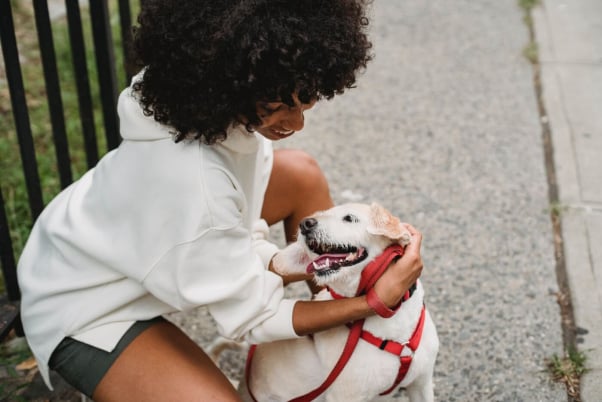It’s not dog training—it’s you training (along with your dog). It’s about learning to communicate with, bond with, and understand your canine best friend—setting yourself up to meet his or her needs to the best of your ability. Writer and bioethicist Dr. Jessica Pierce points out the following:
We don’t always allow our dogs to “be dogs,” and despite their best efforts to integrate into human homes and families, it isn’t always easy work for dogs. We have a chance to improve their well-being by understanding the factors that put them at risk for psychological distress, which may manifest as behaviors we find difficult.
Think about training as time you’ve set aside for you and your dog to be solely dedicated to communicating with each other—and perhaps some time with a trainer who provides guidance. Dogs should enjoy training—it should be fun, or it shouldn’t be happening. This is why choosing the best trainer for yourself and your dog—one who uses only humane, positive reinforcement- and science-based techniques that work with a dog’s instincts, wants, and needs, rather than one who forces obedience—is vital.
Did you know that there are no national or state standards for “trainers”? Anyone can call themselves a “trainer” and start “training,” which means it’s crucial that you do your homework before selecting one.
You might have heard about phrases like “dominance theory” or “board and train” or practices such as using prong collars, e-collars, and crates that set off alarm bells—and they should! You’re right to question everything when it comes to keeping your dog healthy and safe, and that includes when choosing a trainer.
That’s why PETA’s canine companion gurus have put together this comprehensive guide. We’re answering your burning questions, including “What questions should I ask a dog trainer?” and “What are the best dog training methods?” and more.
How Do I Choose a Good Dog Trainer?
The number one thing a good dog trainer should have going for them: positive reinforcement.
Positive reinforcement means rewarding dogs for their engagement, rather than punishing them for not doing certain things. During training, this could mean giving your dog a treat or lavish praise when they walk gently by your side. Research shows that positive reinforcement is the most effective way to teach or boost a dog’s confidence. Plus, it’ll strengthen the bond between you and your dog, resulting in happier, healthier dogs who want to interact—rather than dogs who only engage because they’re afraid of being punished.
One phrase you do want to seek out is “force-free training.” ✔️
Force-free training means never using pain, fear, or intimidation. Forceful tactics like yelling, hitting, using shock/prong/choke collars, and grabbing and/or hanging a dog by the scruff of their neck are not only extremely cruel and abusive but also damaging and ineffective. These pain- and fear-based methods stress and scare dogs, making them more likely to resort to aggression—that is, the opposite of what you’re trying to achieve through training.
Training: It’s for guardians!
Training begins with the one holding the leash. A good trainer will teach you how to understand your dog, be consistent, and better meet your dog’s needs. If you aren’t being trained, it’s time to find a new trainer!

Choosing a Dog Trainer: Beware of These Red Flags
Aversive training techniques get a hard pass.
Remember those ineffective pain and fear tactics? They’re known as “aversive” training methods—they activate the part of the brain (the amygdala) that assesses threats and builds fear-based associations, which, according to the Journal of Veterinary Behavior, interferes with dogs’ ability to gain the confidence that you want them to have.
For example, instead of learning to walk calmly on a leash, dogs handled with aversive methods, such as the use of a prong collar, may instead learn that they can make the pain stop by responding with aggression. They also learn to associate the pain with the person causing it or with what they see, hear, or smell while wearing a torture device, which means that in order to avoid the torment, they may avoid you and/or anything they’ve associated with pain from previous experiences. Walking your dog should relieve their stress, but with a prong collar, they’re suddenly robbed of the ability to enjoy the exercise and sniffing that all dogs look forward to.
Most dog trainers won’t advertise openly that they use aversive (i.e., antiquated and violent) methods. So PETA created a cheat sheet to make it easier to spot red flags. If a trainer advises you to use any of these types of collars or products, you can be sure that trainer relies on fear, pain, and force to try to get dogs to do what they want:
Choke Collars ❌
Designed and used for harsh punishment during training, choke collars (or choke chains) are extremely dangerous. They can cause suffocation, damage to the trachea and/or esophagus, a sprained neck, ataxia (loss of balance or control of bodily movements), paralysis, and irreversible brain damage.

Prong Collars ❌
Like a medieval torture device, prong collars are essentially choke chains with added sharp metal prongs, which can puncture dogs’ skin. They can also crush or puncture holes in a dog’s trachea, or windpipe. Simply put, metal and plastic spikes have no business being around your dog’s neck.

Electronic Shock Collars, aka “E-Collars” ❌
Electric shock collars can cause severe injuries, including pressure sores, burns, and cardiac fibrillation. They can also provoke fear and stress, which can cause dogs to react with aggression and/or avoidance. Even dogs with no history of aggression have been known to become aggressive after receiving shocks from an electronic collar. Even if a trainer claims that the collars work just on the “warning setting” (a beep or light buzz), run in the other direction. For your dog, they’re confusing, abusive, and often ineffective, and ultimately, they cause additional stress and anxiety and sometimes even more aggression.

Another important rule to follow: Never hire a trainer who makes guarantees! Just like us, animals have complex emotions—there’s no “one size fits all” approach. Training can help you learn to communicate better with your dog, but no trainer can guarantee success. So if you encounter one who overpromises, it’s time to say, “Thanks, but no thanks.”
A dog trainer who favors dominance theory? ‘Leave it!’
Dominance theory, sometimes referred to as “alpha” theory, is the phony idea that wolves (and therefore dogs) are in constant competition over hierarchy and that if you—the guardian—can cement your place at the top as the alpha, you can control your dog’s behavior. This discredited theory was popular decades ago, but beware—if you encounter trainers peddling dominance theory today, it means that they haven’t been keeping up.
Dominance-based training has proved to be ineffective. The theory has no biological basis: For one thing, dogs aren’t wolves. For another, wolves live in packs that are much more family-oriented than the “alpha” theory would lead you to believe. The person who came up with this theory in the 1940s studied captive wolves, who—unlike wolves in their natural environment—are forced to live with one another for many years, creating a tense living situation that doesn’t even come close to mimicking wolf packs in nature.
“Dominance” or “alpha” training may encourage guardians to “mimic” dog or wolf behavior, which is preposterous, because we are not dogs or wolves. You wouldn’t sniff your dog’s bum to say “hello” to them, and you shouldn’t try to “cure” aggressiveness by being aggressive. For example, if your dog reacts to other dogs while on a leash, bullying your pup with dominance-based methods won’t make him or her stop seeing other dogs as threats. It will only make your dog more afraid and possibly even more aggressive.
Even (or especially) if you have a reactive dog, don’t fall for the “alpha” myth—don’t let a trainer try to use dominance theory on your dog.
“Board and train” programs won’t fix anything.
We all need time to learn something new, and dogs are no different. The best part about interacting positively with your dog is that it’s a great way to help you understand what your best friend is trying to communicate. But to do so, your participation and dedication are key. This is why a good trainer will be training you—and under no circumstances should your dog be trained unless you are present. So if a trainer suggests a “board and train” program—in which you leave your dog at a training facility—grab Fido’s leash and run in the opposite direction.
Leaving your dog with a stranger is a terrible idea under any circumstances—it’s confusing and scary for your dog, and it’s an invitation to disaster. Take it from Luke Janssen, who learned this lesson in one of the worst possible ways. After picking his canine companion Odie up in November 2021 from a three-week stint at In Touch Dog Training & Rehabilitation in Wisconsin, Janssen said the dog “had bruising on his chest that was explained to [him] as a result of sleeping on the ground in the kennels.” Forcing a dog to sleep on concrete for even one day is cruel enough, but a witness (apparently Shaunna Herrick, a staff member who’s since resigned from In Touch) also sent security camera footage to Janssen. It allegedly shows the facility’s owner lifting Odie by the leash and suspending him from the floor, choking him for roughly seven seconds, and then slamming him to the ground.
PETA’s own undercover investigation of Inghram’s Sit ’N Stay Dog Academy revealed that at the Tampa, Florida, training and boarding kennel, dogs were confined to cages for hours on end, sometimes without water or shade, even as temperatures rose into the mid-90s.
Dogs sometimes escaped from the cages and got into fights. Instead of comforting a dog who was bleeding from a serious wound sustained in an attack by another dog, a manager repeatedly yanked on her collar and roughly attempted to tie her mouth shut with a leash.
Watch the full video below to see more of what PETA’s observer documented while working at the dog “academy,” one that claimed to use “humane and caring methods.”
If your canine friend becomes frustrated or anxious when left alone at home, he or she needs to build confidence, with your help and patience. If your dog routinely experiences intense anxiety, an expert may be needed to determine the cause of the discomfort. Anxiety requires gentle expert handling. Find a qualified and preferably credentialed trainer to assess your dog in your home and then create and help implement a plan tailored to your dog that you will carry out.
If you don’t have the time, patience, or ability to work with a dog humanely and patiently, please don’t get one.
Crate training isn’t a “fix,” either.
No dog should be crated and especially not as punishment. Crates are cages, and no animal should be punished by intensive confinement for exhibiting normal dog behavior that humans may not understand. Click to learn why it’s wrong to crate dogs.
*****
Remember, you are your dog’s biggest advocate and protector. By becoming knowledgeable about the best dog training methods, knowing what does and does not constitute humane dog training, checking dog trainers’ references and Better Business Bureau ratings, you’ll avoid letting your dog become fearful or aggressive toward you or others. And when in doubt, trust your gut—a trainer could meet all the requirements on paper and still be a no-go if he or she doesn’t radiate gentleness.
Want to learn more about the do’s and don’ts of dog training and choosing a dog trainer? Read up on it! If you’re still with us, you’re clearly eager to take a deep dive into force-free training. Doing your own research and perhaps even training your dog yourself is one of the greatest ways to unleash your dog’s happiness. Continue doing the groundwork with help from one or more of these books:
- Unleashing Your Dog: A Field Guide to Giving Your Canine Companion the Best Life Possible by Marc Bekoff and Jessica Pierce
- If Only They Could Speak: Understanding the Powerful Bond Between Dogs and Their Owners by Nicholas Dodman
- The Dog Who Loved Too Much: Tales, Treatments and the Psychology of Dogs by Nicholas Dodman
Help us spread the word:
PETA is a participant in the Amazon Services LLC Associates Program, an affiliate advertising program designed to provide websites with a means to earning advertising fees by advertising and linking to Amazon.com.





